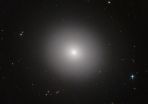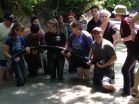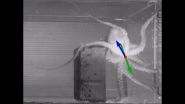(Press-News.org) San Antonio -- April 16, 2015 -- A NASA-funded research team led by Dr. Bill Bottke of Southwest Research Institute (SwRI) independently estimated the Moon's age as slightly less than 4.5 billion years by analyzing impact-heated shock signatures found in stony meteorites originating from the Main Asteroid Belt. Their work will appear in the April 2015 issue of the journal Science.
"This research is helping to refine our time scales for 'what happened when' on other worlds in the solar system," said Bottke, of the Institute for the Science of Exploration Targets (ISET). ISET is a founding member of NASA's Solar System Exploration Research Virtual Institute (SSERVI) and is based in SwRI's Boulder, Colo. office.
The Moon-forming giant impact, which took place between a large protoplanet and the proto-Earth, was the inner Solar System's biggest and most recent known collision. Its timing, however, is still uncertain. Ages of the most ancient lunar samples returned by the Apollo astronauts are still being debated.
The team used numerical simulations to show that the giant impact likely created a disk near Earth that eventually coalesced to form the Moon, while ejecting huge amounts of debris completely out of the Earth-Moon system. The fate of that material has been a mystery. However, it is plausible that some of it would have blasted other ancient inner-solar-system worlds such as asteroids, leaving behind telltale signs of impact-heating shock on their surfaces. Subsequent, less violent collisions between asteroids have since ejected some shocked remnants back to Earth in the form of fist-sized meteorites.
By determining the age of the shock signatures on those meteorites, scientists were able to infer that their origin likely corresponds to the time of the giant impact, and therefore to the age of the Moon.
The SSERVI research indicates that material accelerated by the giant impact struck Main Belt asteroids at much higher velocities than typical Main Belt collisions. The craters left behind by this bombardment contained an abundance of shocked and melted material with formation ages that provide a characteristic of the ancient giant impact event.
Evidence that the giant impact produced a large number of kilometer-sized fragments can be inferred from laboratory and numerical impact experiments, the ancient lunar impact record itself, and the numbers and sizes of fragments produced by major Main Belt asteroid collisions.
Once the team concluded that pieces of the Moon-forming impact hit Main Belt asteroids and made ancient impact age signatures in meteorites, they set out to deduce both the timing and the relative magnitude of the bombardment. By modeling their evolution over time, and fitting the results to ancient impact heating signatures in stony meteorites, the team was able to infer the Moon formed about 4.47 billion years ago, in agreement with many previous estimates.
These impact signatures also provide insights into the last stages of planet formation in the inner solar system. For example, the team is exploring how they can be used to place new constraints on how many planet formation "leftovers," many in the form of asteroid-like bodies, still existed in the inner solar system in the aftermath of planet formation. "It is even possible," Bottke said, "that tiny remnants of the Moon-forming impactor or proto-Earth might still be found within meteorites that show signs of shock heating by giant impact debris. This would allow scientists to explore for the first time the unknown primordial nature of our home world."
INFORMATION:
SwRI scientists Dr. Simone Marchi and Dr. Harold (Hal) Levison also contributed to this work, as well as a team of researchers from the University of Arizona, University of Hawaii, and University of Western Ontario. This research was supported in part by SSERVI at NASA's Ames Research Center in Moffett Field, Calif. SSERVI is funded by the Science Mission Directorate and Human Exploration and Operations Mission Directorate at NASA Headquarters to enable cross-team and interdisciplinary research that pushes forward the boundaries of science and exploration.
For more information about SSERVI, visit http://sservi.nasa.gov
For more information about SwRI, visit http://www.swri.org
Editors: a video is available at http://www.swri.org/press/2015/moon-forming-impact.htm.
April 16, 2015, NEW HAVEN, CT - With poor sanitation estimated to cause 280,000 deaths per year worldwide, improving sanitation is a key policy goal in many developing countries. Yet governments and major development institutions disagree over how to address the problem. A new study released in Science today found that in Bangladesh, a community-motivation model that has been used in over 60 countries to increase use of hygienic latrines had no effect, yet latrine coverage expands substantially when that model is combined with subsidies for hygienic latrines targeted to ...
Astronomers from Chalmers University of Technology have used the giant telescope Alma to reveal an extremely powerful magnetic field very close to a supermassive black hole in a distant galaxy. The results appear in the 17 April 2015 issue of the journal Science.
A team of five astronomers from Chalmers University of Technology have revealed an extremely powerful magnetic field, beyond anything previously detected in the core of a galaxy, very close to the event horizon of a supermassive black hole. This new observation helps astronomers to understand the structure and ...
Astronomers have shown for the first time how star formation in "dead" galaxies sputtered out billions of years ago. The NASA/ESA Hubble Space Telescope and ESO's Very Large Telescope (VLT) have revealed that three billion years after the Big Bang, these galaxies still made stars on their outskirts, but no longer in their interiors. The quenching of star formation seems to have started in the cores of the galaxies and then spread to the outer parts. The results will be published in the 17 April 2015 issue of the journal Science.
A major astrophysical mystery has centred ...
"The answers to extinction, survival and evolution are right here in the dirt," says University of Cincinnati Quaternary science researcher Ken Tankersley, associate professor of anthropology and geology. "And we are continually surprised by what we find."
While many scientists focus on species' extinction wherever there has been rapid and profound climate change, Tankersley looks closely at why certain species survived.
For many years he has invited students and faculty from archeology and geology, and representatives from the Cincinnati Museum Center and Kentucky ...
Washington, DC--Drinking sugar-sweetened beverages can suppress the hormone cortisol and stress responses in the brain, but diet beverages sweetened with aspartame do not have the same effect, according to a new study published in the Endocrine Society's Journal of Clinical Endocrinology & Metabolism.
"This is the first evidence that high sugar - but not aspartame - consumption may relieve stress in humans," said one of the study's authors, Kevin D. Laugero, PhD, of the University of California, Davis, and the U.S. Department of Agriculture's Agricultural Research Service. ...
Washington, DC--People who have osteoporosis face a 1.76-fold higher risk of developing sudden deafness than those who do not have the bone disease, according to a new study published in the Endocrine Society's Journal of Clinical Endocrinology & Metabolism.
Osteoporosis is a progressive condition in which bones become structurally weak and are more likely to fracture or break, according to the Hormone Health Network. More than 40 million people nationwide already have osteoporosis or are at risk of developing the condition due to low bone mass, according to the National ...
This news release is available in French. Quebec City, April 16, 2015--An international study led by researchers from Université Laval and CHU de Québec-Université Laval has identified significant vascular changes in the brains of people with Huntington's disease. This breakthrough, the details of which are published in the most recent issue of Annals of Neurology, will have significant implications for our understanding of the disease and could open the door to new therapeutic targets for treating this fatal neurodegenerative condition.
Huntington's ...
If you are looking to raise money online for your favorite cause, listen up. A real-world analysis of human behavior reported in the Cell Press journal Current Biology on April 16 shows that men treat online giving as a competitive enterprise. Men will donate four times more money to an attractive female fundraiser in response to the contribution of another male.
Researchers say that they suspect this tendency is a subconscious part of human psychology that exists because it is (or was) evolutionarily beneficial to us.
"People are really generous and are right, a lot ...
The body plan of octopuses is nothing if not unique, with a sophisticated brain in a soft, bilaterally symmetrical body, encircled by eight radially symmetrical and incredibly flexible arms. Now, researchers reporting the first detailed kinematic analysis of octopus arm coordination in crawling show that the animals have a unique motor control strategy to match their "odd" form. The researchers report their findings in the Cell Press journal Current Biology on April 16.
"Octopuses use unique locomotion strategies that are different from those found in other animals," ...
Bacteria that naturally reside in the gut are important for health, but recent studies consistently show that a modern lifestyle depletes the gut's collection of microbes. How lifestyle affects the diversity of this gut "microbiome" is unclear, but an analysis of the gut microbiomes of Papua New Guinean and US residents in Cell Reports now suggests that western lifestyle may diminish the variety of bacteria in the gastrointestinal tract by limiting their ability to be transmitted among humans.
"There are several aspects of western lifestyle that have been hypothesized ...






